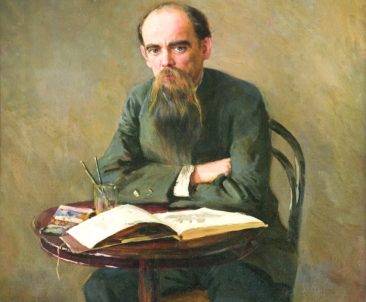
Nikolai Kuznetsov – Russian portrait and genre painter, one of the founding fathers of the society of South Russian artists, participant of international exhibitions and the Paris salons, the owner of a magnificent collection of paintings and a Chevalier of the Legion of honor.
The artist was born in 1850 in the province of Kherson, raised and studied in high school, but scientific subjects were not interested in him. The mother, seeing in his son the ability to draw, took the boy to Odessa to artist Mallman, who was a friend of Kuznetsov family. He was one of the best teachers of the Odessa drawing school, and the young Nicholas began to learn the skills of a master. The teacher fascinated the young artist with his stories about famous painters. Kuznetsov showed a great ability, but still was far from thinking to finally devote himself to art.
Over time and because of social requirements needed to make a final decision about their profession. Then Nikolay Dmitriyevich decided to go to Petersburg to enter the guards. But by chance instead of a guard, he entered the Academy of fine arts.
At the Academy, studying with Professor Chistyakov at the outset Nikolay Kuznetsov has demonstrated remarkable ability. His first pictures appeared at the ninth traveling exhibition in 1881, and immediately drew the attention of the public and critics. Works of the painter became popular, talked about them, interested in them, and none of the travelling exhibition was not without its paintings and portraits.
In 1880-1890-ies the artist positioned himself as a portrait painter. Posed for the artist’s relatives and friends.
The venerable artist – recognized authority in matters of art, he enjoyed universal respect and sympathy. Was friends with Vasnetsov, Polenov, Arkhip Kuindzhi and Repin. The latter even wrote a few portraits Kuznetsova.
In 1920 the artist moved abroad. The last years of his life were spent in exile in Yugoslavia, where he continued to paint, in most cases painted portraits to order.
Died Nikolai Kuznetsov in 1929 in Sarajevo.
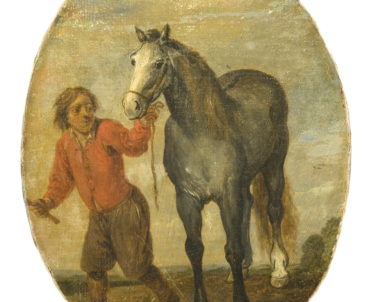
David Teniers the Younger – an outstanding painter and engraver of the Flemish school. He was born in Antwerp in the family of the painter and the father received initial artistic training. Financial difficulties experienced by the family, Teniers made to work extremely hard, with the result that he was admitted to the Antwerp Guild of painters. The artist worked in a variety of genres, he painted portraits and landscapes, still lifes and allegorical scenes, masterfully portrayed animals. However, the bulk of the works were genre scenes from the life of simple people, Flemish peasants.
David Teniers was on friendly terms with the master of the peasant genre of Adrian Brouwer, and works by Teniers in 1630-ies, is very similar to the works of Brouwer, but the Teniers picture is not as gloomy and sad as his friend. Teniers created more idealized images, preferring to ignore the shadow sides of life of the people. The artist especially liked to paint peasants in their leisure, vacationers and merry, fond of writing festivals, a County fair. Only occasionally he depicted scenes of peasant labor – the harvest and the haymaking.
Showed himself to be an artist and a master of landscape. He started with the fantastic landscape of rocks, caves and waterfalls, but, gradually, his art included the image of a truly national Flemish nature, which the artist painted with special love and attention, the bright, major colours, the soft transitions of the brownish-green tones. An important role in landscape painting took the man.
The artist was characterized by a high pace of work. With great accuracy and extreme vigilance, he almost never bothered to correct their work. All the artist had created more than seven hundred works.
Teniers was extremely popular. His skills, entertaining plots of his paintings earned him the reputation among the nobility, and the burghers. In 1651 Teniers was appointed court painter and curator of the art gallery of the ruler of Flanders, the Archduke Leopold Wilhelm.
The artist tried his best to contribute to the development of the art of Flanders, thanks to his efforts in Antwerp for several years lasted the Academy of fine arts.
The master died alone and forgotten, but his art continued to live in the works of numerous students and followers.
Image: David Teniers The Younger. Flanders. A groom with a horse. XVII century (from the collection of WAHM them. I. N. Kramskoy).
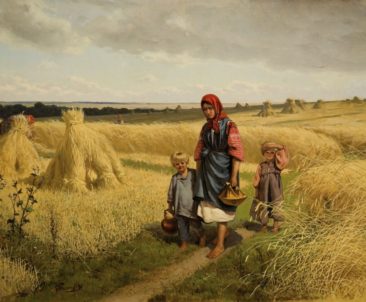
Nikolai Alekseevich Bogatov – Russian painter, graphic artist, doing lithography, worked in the field of landscape and portrait, illustrated the works of Russian classics and folklore, the artist-Illustrator in the magazine “Around the world” and lecturer at the school of fine arts Gunst, the author of the illustrations (lithographs) for the works of Dostoevsky, Lermontov and other writers.
The artist was born in Moscow into a family of court Minister. In 1875 he graduated from the Moscow school of painting, sculpture and architecture, where he studied under V. V. Pukirev, E. S. Sorokin and Vasily Perov.
His first independent work was a success among teachers and students of the Moscow school, and the painting “the Rest of the oxen at the plow” painter received in 1874 a large silver medal of the school, also Bogatov was awarded the title of class artist.
The wizard was exposed quite often. He was the participant of exhibitions in Moscow school of painting, sculpture and architecture, Moscow society of art lovers (in 1878 Bogatov became a member of the organization) also participated in the exhibitions of the Society of Russian watercolors and has exhibited his work in the framework of the Association “St. Petersburg society of artists.”
Died 7 Oct 1935 in Moscow.
His works are in State Tretyakov gallery, Chuvash state art Museum, the museums of Omsk, Sevastopol, Syktyvkar, Tver, and others.

Petrovichev Peter Ivanovich began his journey as an artist as an apprentice of the Rostov Museum of Church antiquities, and not having at that time no special art education. The young artist’s talent was spotted by the great Russian battle painter Vasily Vereshchagin. In 1892 Vereshchagin helped Petrovicheva at the Moscow school of painting, sculpture and architecture, “the forge” great Russian artists, the Wanderers. Petrovichev became a disciple of the great Levitan, who dispelled prevailed in the mind of the young man light the misconceptions and brought him to the wide road of artistic skills, becoming a teacher in life and in art, a warm memory and appreciation which the artist has preserved forever.
After the master’s death in 1900, Petrovichev continue studying at the Valentin Serov. Soon after graduation, in 1904, the artist began to exhibit travelling Exhibitions. He comes to his success, the recognition, his work acquired by the Tretyakov Gallery.
The range of his pictorial interests Petrovichev is defined as follows: “I was fascinated by the Russkaya Starina – the ancient monuments of architecture, familiar from childhood. I repeatedly visited the great Russian cities – Nizhny Novgorod, Kostroma, Yaroslavl, Suzdal, Veliky Novgorod, Vladimir, wrote there his sketches. Later they became material for paintings, devoted to Russian antiquity. On these topics I was working all his life”.
Died 4 Jan 1947 in Moscow, is buried in the cemetery Vagankovsky.
Image: P. N. Petrovichev. View of the village in the autumn evening. 1909 (from the collection of WAHM them. I. N. Kramskoy)
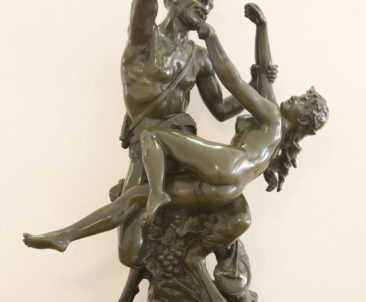
Claude Michel (Clodion) is one of the most attractive masters among the French sculptors of the XVIII century. Birth name Claude, but he took the name Clodion, as if anticipating their uniqueness in numerous family hereditary of Lorraine sculptors and decorators of Adanov, which was connected on the maternal side. However, about the circumstances of his life very little is known of the biography of the artist still remains largely unclear.
He was born in France in Nancy and was the tenth, last child in the family of a merchant. The first lessons the boy received from his uncle Lambert-Sigisbert Adana, after his death, Clodion he studied briefly in the Studio of J. B. Pigalle, and then entered the Royal school for privileged students. In 1762 he received the first prize in sculpture, and among the best graduates were sent to Rome. At the mention of the name of Clodion there are images of beautiful nymphs, saucy satyrs, bacchantes graceful running, frolicking children, cupids, fiddling with each other or carrying heavy bunches of grapes – the Kingdom of carefree childhood and happy youth, the realm of nature, of joy and love, perceived through ancient myths. The world created by Claude Michel is so compelling and poetic, that there is no doubt in his masterly possession of the plastic form.
Created by Klodiana work for ten years in Italy, went Italian, Russian, German, French collections, as works were highly valued. His first works in Rome were the terracotta – figurines of baked clay, which he did independently and in large quantity. Sensitivity to the needs of its time, coupled with internal freedom of world perception, with a special lightness and performance artistry of his terracotta striking subtlety and detail trim parts, soft sculpture and distinctive musicality.
In the sunset years, in the XIX century, the sculptor was the only student J. Maren, who worked in the manner of his teacher. Customers Klodiana were often his friends and the rich bourgeoisie, as was his glory not amenable to precise calculation of terracottas, bronzes, marbles, biscuits, which exist for more than two centuries and are growing in popularity, which caused a wave of copies and even forgeries in the nineteenth century. Not by chance master, for fourteen years survived his century, remained in the history of French art of the eighteenth century the sculptor has embodied in the field of artistic principles of Rococo, “the Fragonard in the sculpture” as it was called by contemporaries.
Samples of his work can be seen in almost all the museums of Europe, as well as in the Hermitage.
Image: K. Michelle. Satyr and nymph. Bronze (from the collection of WAHM them. I. N. Kramskoy).

Dutch artist Abraham Blumart was born in the city of Gorinchem. The boy took the first drawing skills from his father, who was a sculptor and architect, and later continued to improve his skills in Utrecht and Paris.
Blumart had a great influence on the development of Dutch painting, combining in his work the traditions of the Dutch and Flemish painting schools, he painted canvases on historical themes, portraits, genre scenes and landscapes. Numerous engravings and woodcuts, created based on the work of the master, reflect the artistic aspirations of the painter. The manner of the artist’s work with color resembles the work of the Mannerists of the 16th century. Most of the surviving paintings of the painter are kept in the Museum of Fine Arts of San Francisco, as well as in the art galleries of Germany and France.
In addition to the fact that Abraham Blumart was the author of many paintings, he was still an excellent draftsman and engraver, even published a book “The Art of Drawing”, which he himself illustrated. The influence of the artist, a European-style mane-terrier, was very great, in particular, thanks to his studio, which brought together many talented painters, and among his pupils were his sons, they also devoted their lives to art.
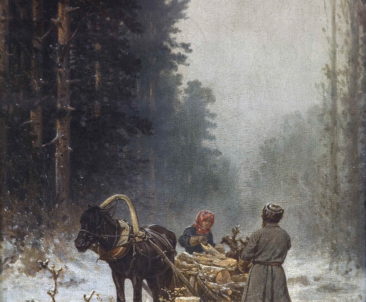
Pyotr Nikolaevich is a painter-battlesist and genre painter.
The artist was born in Kursk in the family of a poor landowner. Since childhood he was fond of painting and independently engaged in drawing, and in 1851 entered the Imperial Academy of Arts in St. Petersburg, in the class of the battalion of Professor BP. Willewalde.
Learning was easy for a young man. Some of the early paintings attracted the attention of academics, moreover, they were awarded medals of gold and silver dignity.
After graduating from the Academy of Arts, Peter Nikolayevich went to Europe. Over the next six years he visited France, Germany, Italy and Austria. During the European period of the life and work of the artist a lot of successful works appeared, which aroused unanimous approval among the ranks of foreign critics. In them, the artist opened up new facets of his talent, describing pictures from French life. He beautifully recreated the plots not only of military operations, but also subtly conveyed all the features and the finest touches of the people’s way of life; however, such a change of activity did not come to the understanding from the Imperial Academy’s superiors, and in connection with this, Gruzinsky was instructed to engage exclusively in battle painting.
In 1865, Petr Nikolaevich went to the Caucasus to prepare sketches for one of his main works “Leaving the aul mountains with the approach of Russian troops.” The canvas made a furore at international exhibitions in London and Vienna, and for him the artist was awarded the title of academician of battle painting. The painter was very good at conveying the drama of war, and, of course, the battle scenes are the most famous paintings of the artist. As a central hero, they are almost always represented by a people glorious in their strength of spirit and therefore invincible.
Gruzinsky, like most of the graduates of the Imperial Academy of Art, devoted his whole life to realism. Looking at his paintings, unwittingly becomes a participant in their events, so clearly and naturally recreated the artist’s compositions and stories of his creations. His landscapes literally breathe the scents of the depicted nature, and the animals imprinted in his works are written out right up to the shine in his eyes.
In the collection of the Voronezh Regional Art Museum. I.N. Kramskoy presents a picture of the “Woodcutter”, in which a peasant and a peasant woman in the winter forest load freshly cut trees onto the wood. Frosty day is slipping towards evening, tired people finish work.
Image: P.N. Gruzinsky The lumberjacks. 1884 (from the collection of the I.N.Kramskoy Art Museum).